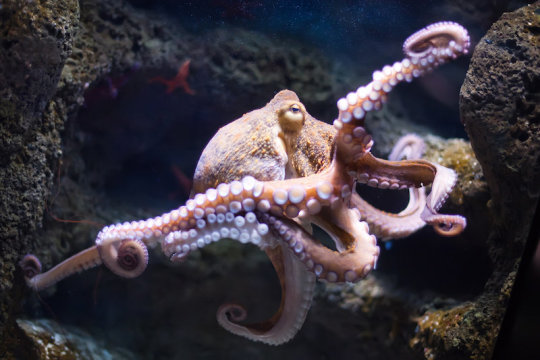[ad_1]
Researchers studying the behavior and neuroscience of octopuses have long suspected that the animals’ arms may have minds of their own.
A new model being presented in Bellevue, Washington State, is the first attempt at a comprehensive representation of information flow between the octopus’s suckers, arms and brain, based on previous research in octopus neuroscience and behavior, and new video observations conducted in the lab.
The new research supports previous findings that octopus’ suckers can initiate action in response to information they acquire from their environment, coordinating with neighboring suckers along the arm. The arms then process sensory and motor information, and muster collective action in the peripheral nervous system, without waiting on commands from the brain.
The result is a bottom-up, or arm-up, decision mechanism rather than the brain-down mechanism typical of vertebrates, like humans, according to Dominic Sivitilli, a graduate student in behavioral neuroscience and astrobiology at the University of Washington in Seattle who will present the new research Wednesday at the 2019 Astrobiology Science Conference (AbSciCon 2019).
The researchers ultimately want to use their model to understand how decisions made locally in the arms fit into the context of complex behaviors like hunting, which also require direction from the brain.
“One of the big picture questions we have is just how a distributed nervous system would work, especially when it’s trying to do something complicated, like move through fluid and find food on a complex ocean floor. There are a lot of open questions about how these nodes in the nervous system are connected to each other,” said David Gire, a neuroscientist at the University of Washington and Sivitilli’s advisor for the project.
Long an inspiration for science-fictional, tentacled aliens from outer space, the octopus may be as alien an intelligence as we can meet on Earth, Sivitilli said. He believes understanding how the octopus perceives its world is as close as we can come to preparing to meet intelligent life beyond our planet.
“It’s an alternative model for intelligence,” Sivitilli said. “It gives us an understanding as to the diversity of cognition in the world, and perhaps the universe.”
The octopus exhibits many similar behaviors to vertebrates, like humans, but its nervous system architecture is fundamentally different, because it evolved after vertebrates and invertebrates parted evolutionary ways, more than 500 million years ago.
Vertebrates arranged their central nervous system in a cord up the backbone, leading to highly centralized processing in the brain. Cephalopods, like the octopus, evolved multiple concentrations of neurons called ganglia, arranged in a distributed network throughout the body. Some of these ganglia grew more dominant, evolving into a brain, but the underlying distributed architecture persists in the octopus’s arms, and throughout its body.
“The octopus’ arms have a neural ring that bypasses the brain, and so the arms can send information to each other without the brain being aware of it,” Sivitilli said. “So while the brain isn’t quite sure where the arms are in space, the arms know where each other are and this allows the arms to coordinate during actions like crawling locomotion.”
Of the octopus’ 500 million neurons, more than 350 million are in its eight arms. The arms need all that processing power to manage incoming sensory information, to move and to keep track of their position in space. Processing information in the arms allows the octopus to think and react faster, like parallel processors in computers.
Sivitilli works with the largest octopus in the world, the Giant Pacific octopus, as well as the smaller East Pacific red, or ruby, octopus. Both species are native to Puget Sound off Seattle’s coast and the Salish Sea, and have learning and problem-solving capabilities analogous to those studied in crows, parrots and primates.
To entertain the octopuses and study their movements, Sivitilli and his colleagues gave the octopuses interesting, new objects to investigate, like cinder blocks, textured rocks, Legos and elaborate mazes with food inside. His research group is looking for patterns that reveal how the octopus’ nervous system delegates among the arms as the animal approaches a task or reacts to new stimuli, looking for clues to which movements are directed by the brain and which are managed from the arms.
Sivitilli employed a camera and a computer program to observe the octopus as it explored objects in its tank and looked for food. The program quantifies movements of the arms, tracking how the arms work together in synchrony, suggesting direction from the brain, or asynchronously, suggesting independent decision-making in each appendage.
“You’re seeing a lot of little decisions being made by these distributed ganglia, just by watching the arm move, so one of the first things we’re doing is trying to break down what that movement actually looks like, from a computational perspective,” Gire said. “What we’re looking at, more than what’s been looked at in the past, is how sensory information is being integrated in this network while the animal is making complicated decisions.”
[ad_2]















